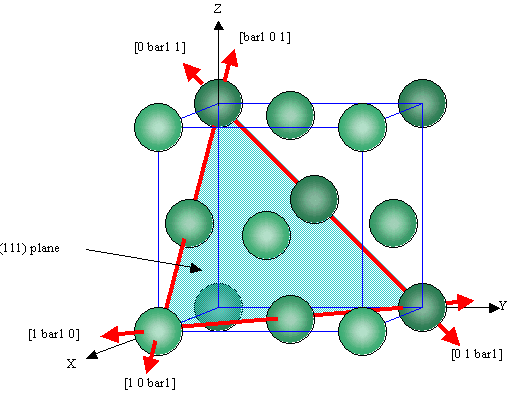Slip in CCP metals
Cubic close-packed (c.c.p.) crystals have slip systems consisting of the close-packed directions in the close-packed planes. The shortest lattice vectors are along the face diagonals of the unit cell, as shown below:

Slip systems in c.c.p. on the (111) plane. There are 3 distinct slip directions lying in this plane, and there are 3 other planes of the {111} type, making 12 distinct slip systems of the <1 bar1 0>{111} type.
The cubic symmetry requires that there be many distinct slip systems, using all <1 bar1 0> directions and {111} planes. There are 12 such <1 bar1 0>{111} systems, five of which are independent. Note that on a given slip system, slip may occur in either direction along the specified slip vector. The c.c.p crystal therefore has many more slip systems than an h.c.p. crystal, and slip progresses through three stages:

Plot of the resolved shear stress τR acting on one slip system against the shear strain γ during deformation of a c.c.p. single crystal.
The initial elastic strain is caused by the simple stretching of bonds. Hooke's Law applies to this region.
At the yield point, stage I begins. The crystal will extend considerably at almost constant stress. This is called easy glide, and is caused by slip on one slip system (the primary slip system).
The geometry of the crystal changes as slip proceeds. The Schmid factor changes for each slip system, and slip may begin on a second slip system when its Schmid factor is equal to that of the primary slip system. In this stage of deformation, known as stage II, dislocations are gliding on two slip systems, and they can interact in ways that inhibit further glide. Consequently, the crystal becomes more difficult to extend. This phenomenon is called work hardening. The stress / strain ratio in stage II may be constant.
Further details of work hardening.
Stage III corresponds to extension at high stresses, where the applied force becomes sufficient to overcome the obstacles, so the slope of the graph becomes progressively less steep. The work hardening saturates. Stage III ends with the failure of the crystal.

